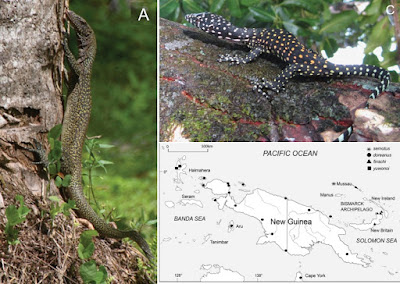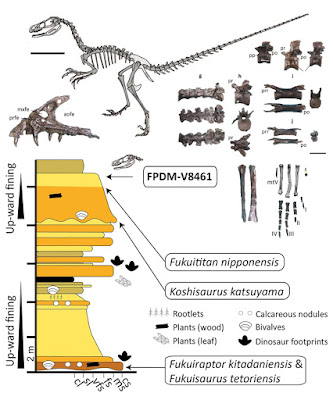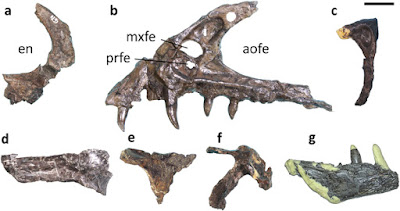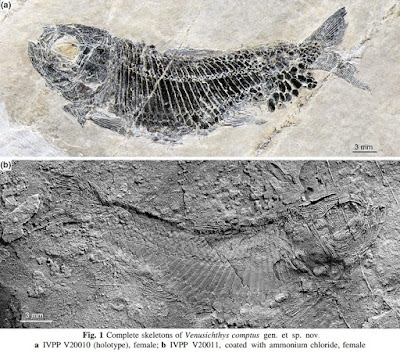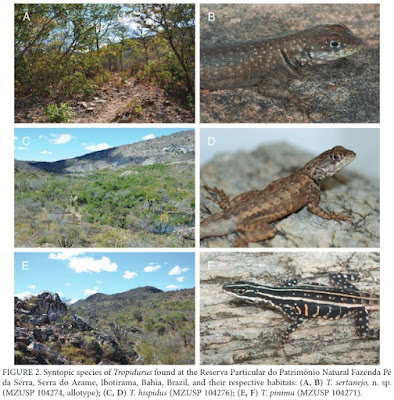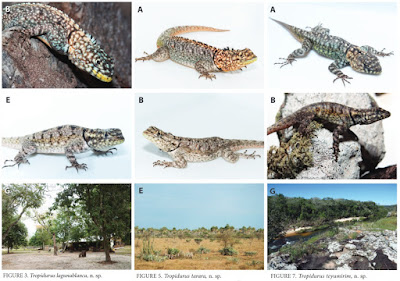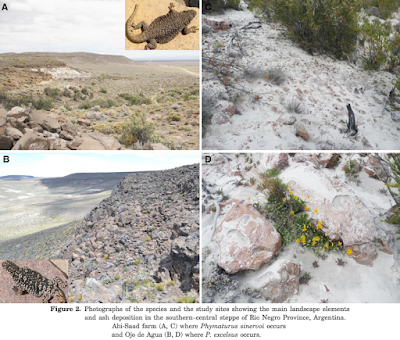[Most Recent Entries] [Calendar View]
Wednesday, February 24th, 2016
| Time | Event | ||||||||
| 1:20a | [Herpetology • 2016] Varanus semotus • A New Blue-tailed Monitor Lizard (Squamata, Varanus) of the Varanus indicus group from Mussau Island, Papua New Guinea
Abstract We describe a new species of Varanus from Mussau Island, north-east of New Guinea. The new species is a member of the Varanus indicus species group and is distinguished from all other members by both morphological and molecular genetic characters. It is the third species of Varanus reported from the Bismarck Archipelago and the first record of a yellow tongued member of the Varanus indicus species group from a remote oceanic island. The herpetofauna of Mussau Island has not been well studied but the discovery of this new species is in accordance with recent findings indicating that the island may harbor several unknown endemic vertebrates. The distribution of the closely related Varanus finschi is also discussed in the light of recent fieldwork and a review of old records. Keywords: Melanesia, Bismarck Archipelago, St. Matthias islands, Varanidae, Varanus doreanus, Varanus finschi, Varanus yuwonoi, mitochondrial phylogeny, biogeography, taxonomy Etymology: The specific epithet semotus is Latin for distant or remote and refers to the isolated occurrence on Mussau, separated by several hundred kilometers from its closest relatives. The term is employed as a masculine adjective. Diagnosis: Varanus semotus sp. n. is distinguished from all other species of Varanus by a combination of the following characters. (1) Tongue white/pinkish to pale yellow (white in preservative) occasionally with small patches of dark pigmentation, the yellow pigment concentrated along the mid-dorsal line and the dorsal surface of the tines (Fig. 2). (2) Gular region marbled in black and cream-white. (3) The tail of adult individuals is indistinctly banded on the distal half, with a varying degree of turquoise to bluish pigmentation on the distal 2/3. (4) Juveniles are black with white spots on the head, yellow and orange spots on the dorsum, and have well defined cream colored to pale greenish tail bands (Fig. 3C). (5) The number of dorsal scales, XY, ranges from 149 to 153. (6) The number of midbody scale rows, S, ranges from 152 to 161. (7) The dorsum is black with single- and clustered groups of dispersed yellow/orange scales. (8) There are several complete rows of paryphasmata across the asulcal side of the hemipenis below the lobes. (9) Geographical distribution restricted to Mussau Island. Distribution: Varanus semotus is known so far only from Mussau, an island of 414 sq.km in the northern Bismarck Sea (Fig. 5). According to some of the locals on Mussau, monitors are absent from Emirau, the second largest island of the St. Matthias group, but this needs confirmation from fieldwork. It is also unknown whether this species occurs on the other two nearby islands Emananus and Eloaua. Natural history: A total of 16 observations were made during fieldwork on Mussau, all of them along the coast near the village of Nai at the SE corner of the island. Searches in the secondary growth forest of the interior of the island and in the mangrove forests near Palakau did not produce any observations. The relatively dry coastal vegetation near Nai comprises a mixture of coconut palms, pandanus and other trees and shrubs able to persist in the karst, limestone and salt spray affected area (Fig. 6). In this vegetation type monitors appeared to be relatively common. Just south of the village there is a freshwater spring with a small area of Sago palms which was also a popular site for monitors. The lizards were usually spotted either as they were foraging on the ground and quickly fled up in trees, or while they were basking on the trunks of palms or other trees. The specimens collected as vouchers were noosed from trees with a long pole. As is typical of the closely related V. doreanus, V. finschi and V. yuwonoi the specimens were exceedingly aggressive and inclined to bite when captured and handled. Stomach content analysis of the three ZMUT specimens revealed a total of five reptile eggs (3,2,0) and one small skink. All stomachs contained the remains of crabs. Philipp et al. (2007) recorded a bird as the stomach content of ZMUC 4272. Conservation. The field observations indicate that V. semotus doesn’t occur, or possibly only at low densities, in the highly degraded secondary forest/bush of large parts of the interior of the island. It is likely that the species occurred throughout Mussau prior to the large scale logging activities of the past three decades (Venter and Arihafa 2015). Thus the species is now mostly restricted to the coastal strip of a relatively small isolated island. Possible threats to the future survival of this species would be the introduction of cane toads which were widely established in the PNG islands during WW2 (Zug et al. 1975). According to unconfirmed accounts by locals they already occur on Emirau Island which also according to local inhabitants on Mussau lack monitor lizards. Varanus semotus is the only large-sized terrestrial generalist predator and scavenger on the island, and may well fill an important ecological function, making it of particular conservation concern. The new species is unusual inasmuch as it fills a role normally occupied by Mangrove monitors on isolated Pacific islands and it can well be considered a biogeographical oddity. Valter Weijola, Stephen Donnellan and Christer Lindqvist. 2016. A New Blue-tailed Monitor Lizard (Reptilia, Squamata, Varanus) of the Varanus indicus group from Mussau Island, Papua New Guinea. ZooKeys. 568: 129-154. DOI: 10.3897/zookeys.568.6872 | ||||||||
| 4:26a | [Paleontology • 2016] Fukuivenator paradoxus • A Bizarre Theropod from the Early Cretaceous of Japan Highlighting Mosaic Evolution among Coelurosaurians
Abstract Our understanding of coelurosaurian evolution, particularly of bird origins, has been greatly improved, mainly due to numerous recently discovered fossils worldwide. Nearly all these discoveries are referable to the previously known coelurosaurian subgroups. Here, we report a new theropod, Fukuivenator paradoxus, gen. et sp. nov., based on a nearly complete specimen from the Lower Cretaceous Kitadani Formation of the Tetori Group, Fukui, Japan. While Fukuivenator possesses a large number of morphological features unknown in any other theropod, it has a combination of primitive and derived features seen in different theropod subgroups, notably dromaeosaurid dinosaurs. Computed-tomography data indicate that Fukuivenator possesses inner ears whose morphology is intermediate between those of birds and non-avian dinosaurs. Our phylogenetic analysis recovers Fukuivenator as a basally branching maniraptoran theropod, yet is unable to refer it to any known coelurosaurian subgroups. The discovery of Fukuivenator considerably increases the morphological disparity of coelurosaurian dinosaurs and highlights the high levels of homoplasy in coelurosaurian evolution. Systematic palaeontology Dinosauria Owen, 1842 Theropoda Marsh, 1881 Maniraptora Gauthier, 1986 Fukuivenator paradoxus gen. et sp. nov. Etymology: “Fukui” refers to Fukui Prefecture in the central Japan, where the specimen was recovered; “venator”, a Latin word for hunter; the species name refers to the surprising combination of characters in this theropod dinosaur.
Holotype: FPDM-V8461 (Fukui Prefectural Dinosaur Museum), a disarticulated but closely associated skeleton found within a 50 by 50 cm area, preserved elements include: incomplete right premaxilla with two isolated premaxillary teeth, left maxilla with one isolated and four intact teeth, left lacrimal, right jugal, right postorbital, left squamosal, both frontals, braincase, possible left ectopterygoid, left pterygoid, right palatine, posterior part of right dentary with two intact dentary teeth, eight cervical vertebrae, 10 dorsal vertebrae, five sacral vertebrae, and 30 caudal vertebrae, several cervical ribs, dorsal ribs, gastralia and chevrons, nearly complete scapulas and coracoids, most of both forelimbs, portions of both pubes, partial left ischium, and nearly complete hindlimbs (Fig. 1).
Type locality and horizon: FPDM-V8461 was found in the Kitadani Dinosaur Quarry, which is on the Sugiyama River in the northern part of the city of Katsuyama, Fukui, Japan (36° 7′ 17.9″ N, 136° 32′ 41.4″ E) (see Supplementary Figs. S1 for quarry maps, and S2 for a field photograph). The quarry is locally referred to the Lower Cretaceous Kitadani Formation (Akaiwa Subgroup, Tetori Group). The age of the Kitadani Formation could be assigned to the Barremian to the Aptian on the basis of occurrences of the freshwater mollusk Nippononaia ryosekiana17 and charophytes18, and radioisotopic dates obtained from related sedimentary units (127–115 Ma?)19. Diagnosis: A relatively small theropod with the following unique features: 1. unusually large external naris (slightly smaller than antorbital fenestra in dorsoventral height); 2. large premaxillary fenestra subequal in size to maxillary fenestra; 3. large oval lacrimal pneumatic recess posterodorsal to the maxillary fenestra on antorbital fossa medial wall; 4. lacrimal with a distinct groove on lateral surface of anterior process and a ridge on lateral surface of descending process; 5. postorbital frontal process with T-shaped-cross section and laterally-flanged squamosal process; 6. an elongate tubercle on posterior surface of basal tuber of the basicranial region; 7. highly heterodont dentition featuring robust unserrated teeth including small spatulate anterior teeth, large and posteriorly curved middle teeth, and small and nearly symmetrical posterior teeth; 8. cervical vertebrae with a complex lamina system surrounding the neural canal resulting in deep and wide grooves for interspinous ligaments and additional deep sockets; 9. anterior cervical vertebrae with interprezygapophyseal, postzygadiapophyseal, prezygadiapohyseal, and interpostzygapophyseal laminae connecting to each other to form an extensive platform; 10. anterior and middle cervical vertebrae with transversely bifid neural spines; 11. dorsal, sacral, and anterior caudal vertebrae with strongly laterally curved hyposphene and centropostzygapophyseal laminae that, together with the postzygapophyseal facet, form a socket-like structure for receiving the prezygapophysis; 12. dorsoventrally bifurcated sacral ribs; 13. caudal zygapophyseal facets expanded to be substantially wider than the zygapophyseal processes; and 14. middle caudal vertebrae with transversely and distally bifid prezygapophyses. Yoichi Azuma, Xing Xu, Masateru Shibata, Soichiro Kawabe, Kazunori Miyata and Takuya Imai. 2016. A Bizarre Theropod from the Early Cretaceous of Japan Highlighting Mosaic Evolution among Coelurosaurians. Scientific Reports. 6(20478); DOI: 10.1038/srep20478 | ||||||||
| 3:27p | [PaleoIchthyology • 2016] Venusichthys comptus • A Middle Triassic Stem-Neopterygian Fish from China shows Remarkable Secondary Sexual Characteristics
Abstract Secondary sexual characteristics are features that appear at sexual maturity and distinguish the two sexes of a species. They are readily observed and studied in living animals, but the phenomenon is rather more difficult to identify in fossil taxa. Here we report a new sexually dimorphic stem-neopterygian fish, Venusichthys comptus gen. et sp. nov., based on 30 exceptionally well-preserved specimens from the Middle Triassic (Pelsonian, Anisian) Luoping Lagerstätte of eastern Yunnan, China. The discovery represents the oldest known secondary sexual characteristics in Neopterygii. These characteristics, including pointed tubercles on cranial bones, scales and fins, and hook-like contact organ anterior to the anal fin, have three inferred primary functions: maintenance of body contact between the sexes during prespawning behavior or spawning; stimulation of the females during breeding; and defense of nests and territories. Lacking a specialized anal fin in the presumed males, Venusichthys would likely have a different reproductive strategy from peltopleurids and other potentially viviparous stem-neopterygians. Moreover, Venusichthys shows a unique character combination distinguished from any other stem-neopterygian families and consequently represents a new family of this clade. As such, the new finding provides an important addition for understanding the behavior, reproduction, and early diversification of Neopterygii. Keywords: Sexual dimorphism; Breeding tubercles; Venusichthyidae; Neopterygii; Actinopterygii Systematic paleontology Neopterygii Regan, 1923 Venusichthyidae fam. nov. Venusichthys comptus gen. et sp. nov. Etymology: The genus epithet is from Latin venus, meaning goddess of love, and ichthys, meaning fish. The species epithet is from Latin comptus, meaning ornamental. Holotype: A nearly complete skeleton of presumed female deposited at the collection of the Institute of Vertebrate Paleontology and Paleoanthropology (IVPP), Chinese Academy of Sciences. V20010. Standard length is 31 mm. Referred specimens: IVPP V20011–20034, 20055–20058; ZMNH (Zhejiang Museum of Natural History, Hangzhou, China) M1695. Type locality and horizon: Luoping, Yunnan, China; second (upper) member of Guanling Formation, Pelsonian, Anisian, Middle Triassic. Diagnosis: A new stem-neopterygian diagnosed by the following combination of features: presence of pointed anterior process of rostral; absence of supraorbitals; quadratomandibular articulation slightly anterior to middle line of orbit; maxilla notably longer than lower jaw; presence of tubercles and contact organ in presumed males; two preopercular elements on each side; two pairs of branchiostegal rays; anterior lateral line scales six times deeper than wide; dorsal fin larger than anal fin; 24 principal caudal fin rays; and squamation formula of D14/P7, A13, C31/T37. Guang-Hui Xu and Li-Jun Zhao. 2016. A Middle Triassic Stem-Neopterygian Fish from China shows Remarkable Secondary Sexual Characteristics. Science Bulletin. 61(4); 338-344. DOI: 10.1007/s11434-016-1007-0 摘要: 第二性征是动物在性成熟所表现的、可以用来分辨物种性别的特征。第二性征比较容易在现 Neopterygian Fish with Secondary Sexual Characteristics Found from Middle Triassic of China | ||||||||
| 3:38p | [Herpetology • 2016] Tropidurus sertanejo • A New Tropidurus (Tropiduridae) from the Semiarid Brazilian Caatinga: Evidence for Conflicting Signal between Mitochondrial and Nuclear Loci Affecting the Phylogenetic Reconstruction of South American Collared L
ABSTRACT Tropidurus Wied, 1825, is one of the most ubiquitous lizard genera distributed in open habitats of tropical and subtropical South America. Nevertheless, the broad representation of specimens of this group in scientific collections is hardly reflected in our knowledge of its taxonomic diversity. Most species currently assigned to Tropidurus began to be uncovered in the early 1980's and additional populations in need of formal taxonomic treatment have been cataloged ever since. Herein, we name Tropidurus sertanejo, n. sp., a new species of the T. torquatus group endemic to the semiarid Brazilian Caatinga. Tropidurus sertanejo, n. sp., is currently known from two isolated populations in the municipalities of Caetité and Ibotirama, State of Bahia, Brazil. This is the only species of the T. torquatus group lacking granular mite pockets on the lateral neck, and it is also diagnosable by having a conspicuous bronze-colored head, a light-brown dorsal body with small pale salmon spots, and small body size in comparison with most congeners. Phylogenetic analyses recovered a paraphyletic Tropidurus, but firmly supported T. sertanejo, n. sp., as member of a monophyletic T. torquatus species group. Trees generated by independent analyses of nuclear and mitochondrial sequence data conflicted with our total evidence phylogenetic hypotheses. Since topological disagreements were detected among phylogenetic trees resulting from maximum parsimony (MP) and maximum likelihood (ML) reconstructions, and MP analyses do not require distinct evolutionary models or partition schemes to be defined prior to conduction of phylogenetic reconstruction, these factors were considered unlikely to explain all the variation in the observed results, favoring the interpretation of conflicting phylogenetic signal. Because detailed information on the distribution, population size, and ecological requirements of T. sertanejo, n. sp., are currently unavailable, we recommend the species to be listed as “data deficient” following the rules proposed by IUCN. André L.G. Carvalho, Marco A. Sena, Pedro L.V. Peloso, Fabio A. Machado, Rachel Montesinos, Hélio R. Silva, Gwyneth Campbell and Miguel T. Rodrigues. 2016. A New Tropidurus (Tropiduridae) from the Semiarid Brazilian Caatinga: Evidence for Conflicting Signal between Mitochondrial and Nuclear Loci Affecting the Phylogenetic Reconstruction of South American Collared Lizards. AMERICAN MUSEUM NOVITATES. 3852:1-66. DOI: 10.1206/3852.1 | ||||||||
| 4:38p | [Herpetology • 2016] Tropidurus lagunablanca, T. tarara & T. teyumirim • Three New Species of the Tropidurus spinulosus group (Squamata: Tropiduridae) from Eastern Paraguay
ABSTRACT Tropidurus Wied, 1825, is one of the most ubiquitous lizard genera endemic to South America. Herpetologists from different regions of the continent have progressively mapped new populations, including undescribed species hidden under widely distributed nominal taxa. Currently, four monophyletic species groups are recognized in Tropidurus (T. bogerti group [monotypic], T. semitaeniatus group [four species], T. spinulosus group [five species], and T. torquatus group [16 species]), but none have been comprehensively revised taxonomically. During a collection expedition carried out in Paraguay in 2013, I recognized three new, distinct morphotypes among populations of the Tropidurus spinulosus group formerly assigned to T. guarani Alvarez et al., 1994. To delimit these new taxa, I analyzed coloration patterns, and quantified meristic and morphometric variables, comparing freshly collected samples with specimens housed in five museum collections. In this paper, I describe and illustrate the allopatric Tropidurus lagunablanca, n. sp., T. tarara, n. sp., and T. teyumirim, n. sp., and provide notes on their distribution limits, natural history, and conservation status. André Luiz Gomes de Carvalho. 2016. Three New Species of the Tropidurus spinulosus group (Squamata: Tropiduridae) from Eastern Paraguay. AMERICAN MUSEUM NOVITATES. 3853:1-44. DOI: 10.1206/3853.1 | ||||||||
| 4:49p | [Herpetology • 2016] Volcanic Ash from Puyehue-Cordón Caulle Eruptions affects Running Performance and Body Condition of Phymaturus Lizards in Patagonia, Argentina
Abstract The Puyehue-Cordón Caulle eruption of 4 June 2011 dispersed about 100 million tonnes of pyroclastic materials resulting in ash accumulations of 30 cm depth on the Patagonian steppe, an area occupied by several lizard species. Herein we analysed, by experimental trials, the effects of ash and slope on running performance of two endemic and vulnerable species, Phymaturus excelsus and Phymaturus sinervoi, restricted to volcanic rock outcrops in Patagonia. We also determined the effect of ash fall on body condition by comparing the same populations before and after the volcanic eruption. Locomotion of P. excelsus, adapted to rocky and steep outcrops, was more affected in a negative way by ash. In contrast, P. sinervoi, which lives in mixed habitats with flat rocks and sandy substrates, ran more slowly on the inclined surface but was unaffected by ash, suggesting the two species are well adapted to the habitats they occupy. In spite of impacts of ash deposition on locomotion and potentially the feeding, reproduction and dispersal activity of P. excelsus, lizards captured 18 months after ash deposition showed improved body condition. Our study site for P. sinervoi received less ash deposition and hence body condition was similar before and after ash fall. We hypothesize that negative effects of ash on lizards were counteracted by competitive release; ash deposition caused an acute and significant increase in mortality of herbivorous competitors such as hares and sheep that feed upon the same flowers and fruits included in the Phymaturus diet. Keywords: body condition; disturbance; maximum running speed; Phymaturus excelsus; Phymaturus sinervoi Nora R. Ibargüengoytía, Facundo Cabezas-Cartes, Jorgelina M. Boretto, Carla Piantoni, Erika L. Kubisch, Mariela S. Fernández, Rafael A. Lara-Resendiz, Fausto R. Méndez-de la Cruz, Alejandro Scolaro and Barry Sinervo. 2016. Volcanic Ash from Puyehue-Cordón Caulle Eruptions affects Running Performance and Body Condition of Phymaturus Lizards in Patagonia, Argentina. Biological Journal of the Linnean Society. DOI: 10.1111/bij.12778 |
| << Previous Day |
2016/02/24 [Calendar] |
Next Day >> |
